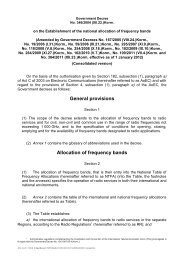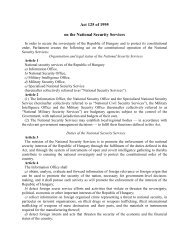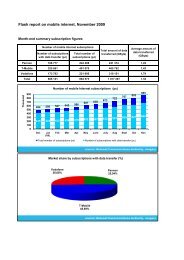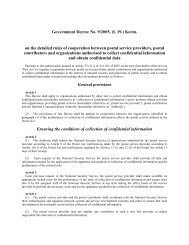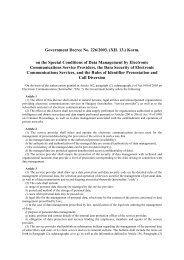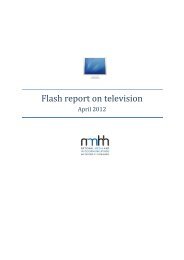The Hungarian Communications Market Developments and ...
The Hungarian Communications Market Developments and ...
The Hungarian Communications Market Developments and ...
You also want an ePaper? Increase the reach of your titles
YUMPU automatically turns print PDFs into web optimized ePapers that Google loves.
54 55<br />
Figure 4.10: Sales of ADSL services<br />
pcs<br />
600 000<br />
Retail ADSL sales of m<strong>and</strong>ated service providers<br />
Country-wide bitstream<br />
500 000<br />
400 000<br />
300 000<br />
200 000<br />
100 000<br />
0<br />
2003 2004 2005 2006 2007<br />
Source: NHH<br />
During 2004, the sale of ADSL services increased dynamically to<br />
go beyond 240 thous<strong>and</strong> by the end of the year. <strong>The</strong> proportion of the<br />
retail customers of ADSL service providers with their own networks<br />
slightly increased over the previous year to exceed 63 percent. At the<br />
same time, the proportion of end-users served by Internet service<br />
providers (ISPs) dropped to 36.8 percent. During 2005, Internet<br />
service providers continued to loose their retail market share to hit<br />
34.3 percent, the lowest level ever, by the end of 2005. Nevertheless,<br />
the entire market continued to undergo a dynamic expansion, with<br />
the total number of ADSL subscriptions increasing to 413 thous<strong>and</strong>.<br />
Following the trend of the previous two years, the proportion of endusers<br />
served by service providers with own ADSL networks further<br />
increased to 65.7 percent (307 thous<strong>and</strong> subscribers).<br />
In 2006, the decrease in the ratio of wholesale realisations<br />
stopped: by the end of the year the proportion of sales by ISPs<br />
as compared to total ADSL sales increased to 36.1 percent (162<br />
thous<strong>and</strong>). <strong>The</strong> year 2007 saw further improvement of the relative<br />
market positions of Internet service providers, with their share in the<br />
retail market increasing to 37 percent by the end of the period under<br />
review. <strong>The</strong>n, the number of end-users served by ADSL technology<br />
was 739 thous<strong>and</strong>, from which 200 thous<strong>and</strong> end-users were<br />
customers of independent ISPs.<br />
<strong>The</strong> number of wholesale realisations dynamically increased during<br />
the period under review. Such growth was essentially due to the<br />
expansion of the entire broadb<strong>and</strong> market, rather than exclusively<br />
to the effects imposed by the relevant obligation. Nevertheless, the<br />
proportion of countrywide bitstream sales, namely the market share<br />
of independent ISPs during 2006-2007 was not lower as compared<br />
to the period before imposition of the obligation. Thus the regulation<br />
has partly reached its objective, whereby competitors using wholesale<br />
products were not squeezed out of the retail market. In the<br />
years following the imposition of the obligation, the slow exclusion<br />
of competitors from the retail market has stopped, with their share<br />
again coming closer to 40 percent. It must be noted though, that the<br />
market positions of alternative service providers, as regards their<br />
share, did not effectively improve, so the regulatory objectives aimed<br />
at the intensification of competition were only partly met.<br />
Nevertheless, in certain geographical markets both the development<br />
of the broadb<strong>and</strong> ADSL market <strong>and</strong> the use of the regulated wholesale<br />
input was attained to different extents. Broadb<strong>and</strong> ADSL access<br />
became available at the various service providers in different times, thus<br />
justifying differences in the development right from the beginning.<br />
In the case of Hungarotel, Monortel <strong>and</strong> Emitel (the latter has<br />
merged into Magyar Telekom), the development <strong>and</strong> sale of ADSL<br />
services were launched later than at the two larger market players.<br />
Within the former areas of Hungarotel, ADSL penetration remains<br />
significantly lower than the countrywide average as opposed to the<br />
roughly 25 percent values of other service providers. <strong>The</strong> reason for<br />
the very high ADSL penetration in the area of Monortel is DSL being<br />
the only fixed residential broadb<strong>and</strong> technology, as cable television<br />
is also the interest of Monortel-owner UPC <strong>and</strong> broadb<strong>and</strong> service is<br />
not provided through the cable network in this area.<br />
As regards the use of the wholesale input, certain geographical<br />
markets are marked by even more differences. Competition is<br />
most intense in the area of Magyar Telekom, where practically every<br />
third ADSL subscriber is a customer of an independent ISP. In the<br />
case of Invitel, the share of ISPs showed a slow decrease in the last<br />
years, as compared to the earlier nearly ten percent. In the case of<br />
Monortel <strong>and</strong> Hungarotel, following the imposition of the obligation,<br />
ISPs did appear, yet their market share was significantly lower than<br />
the one-third ratio of Magyar Telekom.<br />
As a result of the regulation, by the end of the period (since 2006), a<br />
retail service provider different from the former incumbent was a real<br />
option in the area of all five services providers having DSL infrastructure.<br />
Before the decision of the Board, alternative Internet service<br />
providers could only be selected in the areas of two service providers<br />
(Magyar Telekom, Invitel). <strong>The</strong> obligation brought positive changes for<br />
consumers (especially for those living in the areas of these three service<br />
providers) because of the expansion of the supply of retail services.<br />
Before the decision of the Board, two independent ISPs operated<br />
in the service area of Invitel, <strong>and</strong> 16 in the service area of Magyar<br />
Telekom. After the introduction of the obligation of bitstream provision,<br />
ten ISPs were to choose from the service areas of Hungarotel.<br />
In the case of the service areas of Invitel four, in case of Emitel <strong>and</strong><br />
Monortel only one ISP was available for the consumers at the end of<br />
the period under review. By the end of the period, end-users could<br />
select from as many as 25 different service providers in the service<br />
area of Magyar Telekom.




